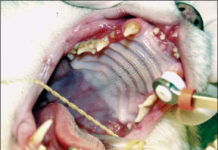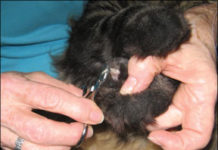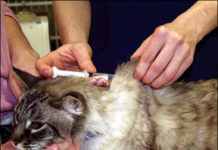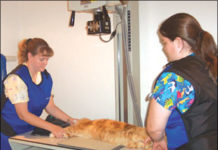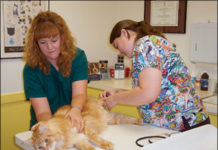Feline Dental Disease
It may surprise you to learn that dental disease is the most common disease in cats. In fact, approximately 50 percent of all cats show signs of gum and teeth problems by the time they reach adulthood. What is dental disease and what can you do to prevent it from happening to your cat? Periodontal disease - which includes gingivitis and periodontitis - is a serious condition that, when left untreated, can lead to tooth loss and may even cause damage to vital organs because bacteria from the mouth can circulate through the bloodstream. Gingivitis is an inflammation of the gums that is caused when plaque bacteria accumulate on the tooth surface and in small pockets at the gumline called the gingival sulcus. According to Daniel Carmichael, DVM, a veterinary dentist at the Veterinary Medical Center in Islip, New York, "The gum tissue or gingiva senses the bacterial plaque, which causes the capillaries to dilate and bring in white blood cells, thus making the gums red, swollen and prone to bleeding."
Care for Your Cat’s Claws
The typical cat will spend up to 18 hours a day sleeping and as much as 50 percent of its waking hours meticulously grooming itself. In addition to persistently licking its coat in order to keep it clean and free of dirt and parasites, the animal will pay special attention to its claws, which serve it well as invaluable tools and, when the need arises, as formidable weapons. "A cat in the wild uses its claws for a wide variety of purposes," says William Miller, VMD, medical director at Cornell Universitys College of Veterinary Medicine. "It will use them to scratch its skin when it itches, mark its territory, provide traction when it wants to climb a tree trunk, or dig a hole to go after a mouse. A cat will also use its claws to conceal its scent from predators by scratching dirt over a spot where it has urinated or defecated." In the course of their routine activities, most cats - especially those that spend a lot of time outdoors - will be able to maintain their claws at proper length, notes Dr. Miller. Cats that live mainly indoors will usually be able to accomplish this as well if they have access to a sturdy scratching post. In some cases, however, a cats claws can become too long, a situation that can have harmful implications for the animal and possibly its owner.
The Danger of String
Brooke Remy of Boston, MA, was delighted to watch her cat Puddles play with a long, pink ribbon she had just taken off a gift box. He twirled around and around and rolled over on the floor. Brooke tired before Puddles did, and left the room for about five minutes. When she returned, the ribbon was gone - except for about two inches sticking out of Puddless mouth. He was coughing and drooling. Running over to him, Brooke began slowly pulling the ribbon out of his mouth, watching in terror and amazement as she removed eight inches of wet pink ribbon from his throat. Puddles was lucky that Brooke had returned in time. If he had swallowed the ribbon without Brookes quick intervention, he could have suffered very serious, even life-threatening, damage to his intestinal tract.
Combat Feline Cancer
An estimated two percent of the 80 million or more cats now living in the United States will at some point in their lives develop cancer, a disease marked by the uncontrolled proliferation of cells on or within an animals hard and soft body tissues. Thanks to dramatic advances in veterinary medicine, many types of feline cancer are manageable - sometimes even reversible - if the condition is recognized early in its development and the affected cat is treated promptly and appropriately. But any cancer that remains undetected and untreated until it has reached an advanced stage is very likely to prove fatal. The task of diagnosing and treating feline cancer falls, of course, to the expert veterinary oncologist. Owners, however, can play a significant role in spotting a cancerous lesion at its earliest stage of development, when it is most amenable to treatment. Indeed, there are measures that a cat owner can take to prevent certain types of feline cancer or at least to minimize the risk of their occurrence.
The Musculoskeletal System
A healthy cats uniquely stunning physical traits - its power, agility and lightning-fast responses to external stimuli - are essentially attributable to its musculoskeletal system. In one way or another, this system is in operation 24 hours a day, whether a cat is hunting prey, escaping from predators, eating, drinking, napping, toying intently with a ball of yarn or digging its claws into your favorite piece of furniture. Unfortunately, cats are subject to a veritable host of disorders that can impair or totally impede the smooth operations of this impressively complex array of bones, muscles, tendons, ligaments and other tissues. Owners should be aware of the systems basic structure, various functions, and signs of its impairment, such as a noticeably altered gait, an apparent weakness in the joints, and the inability to chew and swallow food easily. As is the case with other feline disorders, says Christine Bellezza, DVM, a consultant at Cornell Universitys College of Veterinary Medicines Feline Health Center, early recognition and diagnosis of a cats musculoskeletal disorder are likely to improve the chances for its successful treatment.
Is Your Aging Cat Seeking Attention?
These days, despite what we like to consider modern conveniences, people commonly complain that they just cannot find the time to get a good nights sleep. So much to do, so little time. When we finally do settle into bed, we like to be left to our dreams, undisturbed until the alarm takes us to tomorrow. Noisy neighbors, construction crews and barking dogs are beyond our control. But, what an unexpected, and unpleasant, surprise to be awakened by ones own cat! Restless behavior may be particularly hard to understand when your cat has spent the first 12 years of his life refusing to leave the covers until a decent sunbeam appears. The first time that a senior cats cries call a person from sleep, there may be a sympathetic response. A naturally concerned owner might check the food supply. The next occurrence will be more puzzling. Clearly the cat is not wanting for food. Could there be another cat in the yard? Maybe a critter got into the house?
Short Takes: 11/08
A recent report in the Journal of the American Veterinary Medical Association provided encouraging reassurance that lessons were learned from the tragic melamine contamination of pet food in 2007. Several of the investigators in the study "Clinicopathologic, histologic, and toxicologic findings in 70 cats inadvertently exposed to pet food contaminated with melamine and cyanuric acid" (JAVMA Vol. 233, No. 5) were from Cornell, where the New York State Animal Health Diagnostic Center did some of the groundwork that led to the largest recall of cat and dog food in U.S. history. The 70 cats in this study were not privately owned, nor were they laboratory cats that were deliberately fed suspect food to see if theyd get sick. Rather, they were 70 animals (from a licensed commercial cattery) that happened to be engaged in scientific diet-preference studies when the melamine contamination problem hit the national news. It was their good luck, however, to be where expert veterinary medical care was immediately at hand.
Treats: Don’t Overdo It!
A fine way to show your deserving cat that youre a wonderful human being is to give her a delicious treat now and then - a scrap of baked salmon, for example, or a tiny slice of chicken from your dinner plate. Or perhaps youll unwrap a new pack of its favorite commercial snack - a chewy chicken-flavored tidbit that you discovered on the shelves of your local grocery store. This give-and-take interaction with your cat is perfectly all right, says Francis Kallfelz, DVM, a professor of veterinary nutrition at Cornell Universitys College of Veterinary Medicine, as long as you practice it in moderation and with appropriate vigilance. "The main reason that cat owners give treats is to enhance the human-animal bond," he says, "and there is nothing inherently wrong with that. In fact, theres a good chance that offering treats now and then will make your cat more responsive to you." He points out, however, that any treat should be considered a component of a cats overall daily diet and that, of course, it should be a substance that is safe for feline ingestion. Also, he advises, "Be sure that your cat doesnt become so addicted to treats that it starts refusing to eat its regular food."
Dealing With Diabetes
Most affected cats will require dietary change and daily insulin injections, but overall its a highly treatable condition. Heres help.
Feline Vision Problems: A Host of Possible Causes
Owing to several unique features developed over centuries in the wild, the modern cat typically possesses powerful visual acuity that enables it to function effectively both indoors and beyond the confines of its home. Unfortunately, the feline ocular apparatus is vulnerable to injuries and a wide variety of diseases that can dramatically impair a cats eyesight or, worst case, render it partially or totally blind. "We see cats that are either blind or going blind several times a week," says Thomas Kern, DVM, associate professor of ophthalmology at Cornell Universitys College of Veterinary Medicine. "Most of these animals have eye disease as a primary disorder - they have no other health problems. And most of them are middle-aged or elderly cats whose vision loss has been progressing for years." As is true for virtually all threats to feline health, the earlier a cats vision problem is diagnosed, the more effectively it can be treated - unless, of course, the animals blindness has progressed irreversibly by the time it is noticed. Therefore, Dr. Kern urges owners to keep an eye out for any behavioral or physical indications that a cat is having a vision problem and to report any such signs to a veterinarian without delay.
Finding Emergency Care
Perhaps the most important characteristic of a responsible cat owner is the ability to distinguish the signs of minor feline illnesses from those calling for an immediate trip to the nearest animal emergency care facility. Cat owners should be equipped ahead of time to deal promptly with such a crisis. They should know precisely where the clinic is located, the speediest route to get there, how to transport the afflicted animal, what documents they should take to the facility - and what to expect to happen upon arrival. Feline emergency cases are by no means rare, says Gretchen Schoeffler, DVM, chief of emergency and critical care services at the Cornell University Hospital for Animals (CUHA). She and her colleagues typically treat as many as 10 or 15 severely ill cats each week in the hospitals emergency unit, which, like most such facilities in the U.S., is open 24 hours a day, seven days a week.
Help Calm Anxiety at the Vet’s Office
Isnt it remarkable that most cats are well-behaved when they visit their veterinarians? First, they are captured and put into an automobile. They remain in their containers, sheltered but helpless, in a room filled with the scent of unfamiliar cats, humans and even dogs. Finally, every bit of security is lost when the cat is removed from its newfound shelter and the veterinary team places the cat on the examination table. Why do cats behave so nicely? Fear can sometimes render a cat motionless and therefore cooperative. Fearful cats - whether immobile or aggressive - can benefit from a behavior modification specifically designed to address high arousal. But what about the average cat, dare I say the "normal" cat? There may be no indication for intensive therapy or anxiety-reducing medication. But clearly, the veterinary experience is not entirely stress-free. Rather than take a cats good behavior for granted, why not reduce some of the stressors that can occur during a visit to the veterinary hospital? Lets examine some components of the visit that could trigger anxiety.






